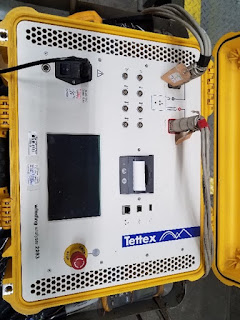Post #5 – Computers in the Workplace [CLOs: 1, 2]
There are three components that make up an electric power system, generation, transmission, and distribution. Computers have a major role in developing, maintaining, and testing each component of the electric power system see Figure 1. They control, monitor, and analyze the flow of power from generation to the customer.
Figure 1 – The Bulk Power System
Another need for computers is to create Word documents and spreadsheets for the specifications and design standards of the power system (Figure 2 shows a design standard format in Word).
Figure 2 - Typical Engineering Standard Document
The SCADA (Supervisory Control and Data Acquisition) system used computers to monitor and control switchgear that is used to connect and disconnect power to the electric grid. Figure 2 show switchgear used to connect and disconnect distribution power under 10,000 volts.
Figure 3 – Pad mount Switchgear
The test equipment that checks the status of the electric circuits and equipment used in the power system use computers to run test routines to verify requirements are met.
Figure 4 – A Hybrid Computer Used to Test Transformers
Computers are used to perform load analysis on transformers to determine if it can handle the loads needed during peak hours of operation. Figures 5 show a transformer being tested and Figure 6 shows the computer used to monitor and record the test results.
Figure 5 – Distribution Transformer Under Test
Figure 6 – Test Equipment Used to Monitor and Record Test Results
Hybrid computers are also used in relays which are
called IEDs (Intelligent electronic devices). These relays protect the power
system from faults like lightning, short circuits, and overloads. They have
communications ports for send status and receiving commands to open or close a
circuit.
Computers are used to design, generators, transmission
line, distribution systems, all the devices needed to keep the power system up
and running. Using CAD (computer aided design) software, drawings are developed
specifying the characteristics of the components documented in the
specification.
Computers are used host the bidding software that publishes and receive bid requests for equipment and services needed to maintain the power system.
Figure 7 – Bidding Website Used to Procure Power System Equipment
and Services
Computers are also used in the meters that monitor and
record the electricity used by customers. Most of these devices have wireless
communications (Figure 8) and can be monitored from the main office computer or
by handheld computers used in the field.
Figure 8 – Power Meter with Wireless Communications (also called a hybrid computer)
In summary, all power systems need a computer to
operate efficiently. It provides personal with technical information on how to
operate, repair, or analyze the components. Computers allow the remote
operation of switchgear that can provide more power to customers when needed
and reduce power when not needed. They also give customers real-time access to
their bill to see if too much power is being used and allow them to make
changes to reduce costs. The Power System uses all three types of computers,
Analog computers for high-speed switch of relays, digital computers for the
precision needed to calculate consumptions, and hybrid computer for testing
circuits and equipment. Within the next ten years computers will be connected
over wireless network and provide monitoring capabilities to identify faults
like wildfires (hybrid computers with cameras and wireless communications are
being tested to monitor powerlines in remote locations). Today there a
cybersecurity concern with using wireless technology to control equipment, a
hacker could connect to the grid from anywhere putting the Power System at
risk. In the future, better security measures should be in place to prevent
hacking wireless networks.
In
response to comments from the discussion form I wanted to answer the question
on why employees need to be computer literate, I can only vouch for the
procedures used in the LADWP (Los Angeles Department of Water and Power).
At LADWP, all engineers, operators and electrical workers go through
extensively training and certifications (when required) before being allowed to
operate, maintain, install, or repair the equipment used in the power system.
More than half of this training is with interactive programs on a computer (the
rest of the training is on the actual equipment). In conclusion, all employees
must use a computer to be certified before they are allowed to do any work on
the power system. As to why employees need be able to use a computer in their
work is simple, computers are used to document specifications, drawings,
schematics, monitor and the status of equipment. Every aspect of the power
system is either stored, displayed, controlled, or processed by computers and
some level of knowledge of computers in needed by every employee in order to
maintain and protect it.
There
was also a suggestion that the power industry find ways to reduce power losses
that occur during transmission and distribution. It is accepted that about 50
percent of the power generated will be lost before it reaches customers. This
loss is due to the long distances the power must travel and the switching
required to step-up of step-down the voltage. For each transformer used there
are losses. Sometime the transmission line runs over a thousand miles and no
matter what medium is used to carry the electricity. Trying to install zero
lost conductors and improving transformer efficiency (the best transformers are
at about 85 percent) is not particle with the technology we have today. Using
better conductors is too expensive and it would not save enough power to
justify. To compensate for the line losses, the electricity is step-up to high
voltages like 100,000 or 700,000 volts, so line losses and transformer
efficiency will not become a factor in distributing the power.









No comments:
Post a Comment